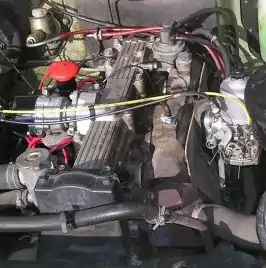| BL O-series | |
|---|---|
 | |
| Overview | |
| Manufacturer | British Leyland Motor Corporation Austin Rover Group |
| Also called | Rover M8 |
| Production | 1978–1993 |
| Layout | |
| Configuration | Straight-4 |
| Cylinder block material | cast iron |
| Cylinder head material | aluminium |
| Valvetrain | SOHC |
| Combustion | |
| Fuel system | Carburettor or Fuel Injection |
| Fuel type | petrol |
| Cooling system | water-cooled |
| Chronology | |
| Predecessor | |
| Successor | |
The BL O-series engine is a straight-4 automobile engine family that was produced by the Austin-Morris division of British Leyland (BL) as a development of the BMC B-series engine family. (See also another B-series successor, the BMC E-series engine.)
Introduced by BL in 1978 in the rear wheel drive Series 3 Morris Marina and the smaller engined versions of the front-wheel-drive Princess, it was intended to replace the 1.8 L B-series unit. The main advance over the B series was that the new unit was of belt driven overhead camshaft configuration, with an aluminium cylinder head.
Design
Offered in the unusual capacity of 1.7 L as well as 2.0 L, it proved to be reliable and was widely used in BL vehicles. These included the rear wheel drive Morris Ital of 1980 (1.7 L or 2.0 L with an automatic gear box), the rear wheel drive Rover SD1 of 1982 (2.0 L only), and 1.7 L and 2.0 L in the front wheel drive Austin Ambassador – in fact the only engine offered in this model. In 1984, it was reworked for installation in high specification 2.0 L versions of the front-wheel drive Austin Maestro and Austin Montego, where it was later optionally available with fuel injection or turbo-charging. This installation of the O-series was adapted for use with the Honda PG-1 end-on manual gearbox, replacing the gearbox-in-sump design traditionally used on British Leyland front-wheel-drive products. The 1.7 L O-series was not used in these vehicles, which featured R- and later S-series 1.6 L units instead. The cylinder blocks of the transmission-in-sump (Princess/Ambassador), rear wheel drive longitudinal (Marina/Ital/Rover SD1), and the transverse, end-on transmission (Maestro/Montego/Rover 800) versions are not interchangeable.
A notable advantage of the 2-litre, petrol O-series engine is that the cylinder head does not require modification to run on unleaded petrol due to having hardened valve seats. Other O-series engines, however, cannot run on unleaded without modification of the cylinder head or use of an additive.
By 1987, British Leyland (now known as the Rover Group) equipped the O-series with a 16-valve cylinder head for the Rover 800. This 2.0 L unit was known as the M series, and was further reworked into the T series in 1992. The 8-valve version of the O-series was also briefly used in budget versions of the Rover 800, although confusingly this was given the "M8" designation in official Rover service publications – implying it was an 8-valve version of the M Series engine, although it was identical to the O series used in the Maestro and Montego.
1.7L petrol engine
The 1.7L displaces 1698cc (103.8 cu in). It is an 8-valve SOHC design with an aluminium head and iron block. The engine is a spark-ignition 4-stroke naturally aspirated petrol engine. Fuel system is via carburettor. Power is 58 kW / 79 PS / 78 hp (DIN)/ 5150 rpm in the Morris Marina, and 62 kW / 84 PS / 83 hp (DIN)/ 5200rpm in the Austin Ambassador. Net torque is 131 Nm / 97 ft-lb / 3500 rpm [1]
Bore x stroke: 84.46 mm × 75.79 mm (3.33 in × 2.98 in)
Applications
- 1978 - 1980 Morris Marina
- 1980 - 1984 Morris Ital
- 1982 - 1984 Austin Ambassador
2.0L petrol engine
The 2.0L displaces 1994cc (121.9 cu in). It is an 8-valve SOHC design with an aluminium head and iron block. The engine is a spark-ignition 4-stroke naturally aspirated petrol engine. Fuel system is via carburettor. Power is 74.5 kW / 101 PS / 100 hp (DIN)/ 5250 rpm in the Austin Ambassador. Net torque is 163 Nm / 120 ft-lb / 3250 rpm [2]
Bore x stroke: 84.46 mm × 88.9 mm (3.33 in × 3.50 in)
Applications
- 1980–1984 Morris Ital
- 1982 Rover SD1
- 1982–1984 Austin Ambassador
- 1984–1992 Austin Maestro
- 1994–1993 Austin Montego
Diesel versions
In 1986, BL collaborated with Perkins to convert the O-series to run on diesel. The oil-burning versions, known as the Rover MDi or Perkins Prima, proved to be highly successful in the Maestro and Montego, and helped sustain the ailing mid-sized models into the 1990s. Perkins successfully marketed the engine under its own brand in the industrial and marine sectors.
Examples of vehicles using a version of the O-series engine:
- Austin Maestro 2.0 L, 2.0 L diesel
- Austin Montego 2.0 L, 2.0 L diesel
- Leyland Sherpa/Freight Rover Sherpa/200/300 1.7 L, 2.0 l
- Princess / Austin Ambassador 1.7 L, 2.0 L
- Morris Ital 1.7 L, 2.0 L automatic
- Morris Marina 1.7 L
- Rover SD1 2.0 L
- Rover 820 2.0 L
- MG Maestro 2.0 L
- MG Maestro 2.0 L, turbo
- MG Montego 2.0 L
- MG Montego 2.0 L, turbo
- Naylor/Hutson TF 1700[3]
References
- ↑ https://www.automobile-catalog.com/auta_details1.php#gsc.tab=0
- ↑ https://www.automobile-catalog.com/auta_details1.php#gsc.tab=0
- ↑ Mastrostefano, Raffaele, ed. (1985). Quattroruote: Tutte le Auto del Mondo 1985 (in Italian). Milano: Editoriale Domus S.p.A. p. 643. ISBN 88-7212-012-8.